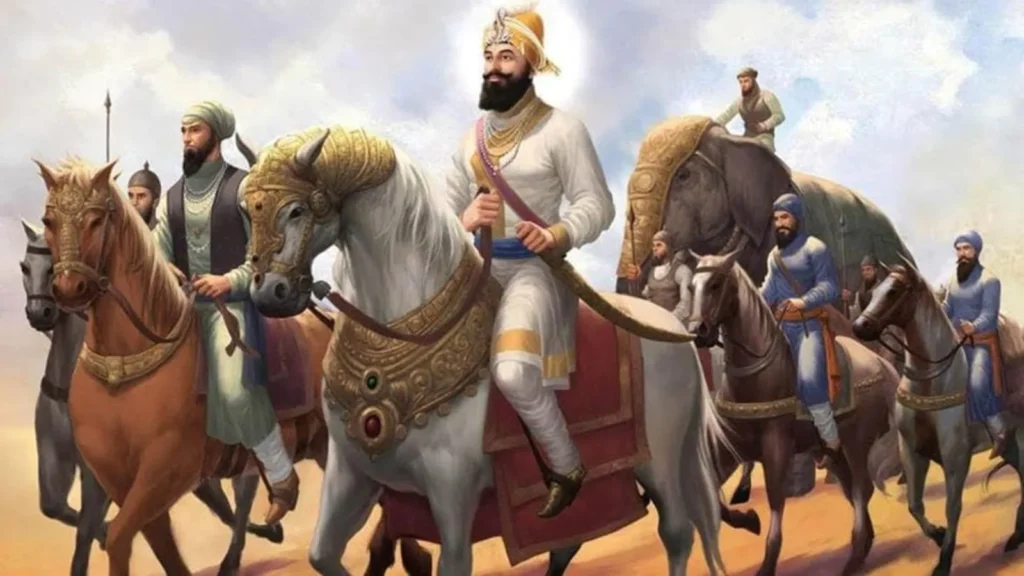About Guru Gobind Singh Ji
Sri Guru Gobind Singh Ji was the tenth Guru or Prophet of Sikh Religion or Faith. His birth name was Gobind Rai Sodhi and he was born in Bihar on 22nd December 1666 i.e. 23 Poh 1723 in the Gurmukhi calendar.
Other than being the last Guru of Sikhs, he is chiefly renowned as the creator of Khalsa (means the pure) i.e. Sikh military brotherhood. He preached a very significant lesson in Persian in Zafarnamah’s Couplet, which is- “When all other means have failed, it is but lawful to take to the sword”. He acquired Sri Guru Gobind Singh Ji was the tenth Guru or Prophet of Sikh Religion or Faith.
Other than being the last Guru of Sikhs, he is chiefly renowned as the creator of Khalsa (means the pure) i.e. Sikh military brotherhood. He acquired some extraordinary intellectual attainments and knew distinct languages like- Sanskrit, Arabic, and Persian. He was the one that laid down the codes for the laws in Sikhism and even he wrote the Dasam Granth. Guru Gobind Singh proclaimed himself as the last person Prophet of Sikhism and ordered the Sikh people to consider Adi Granth- The Sikh Holy Book (Guru Granth Sahib Ji) as the Guru.
Introduction to Sikh Empire
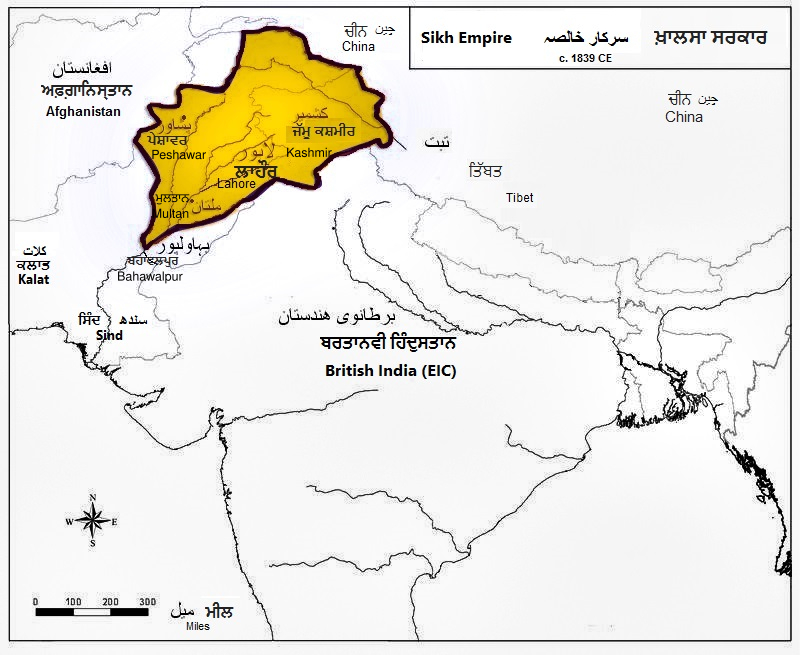
The Sikh Empire(Today’s North India/Pakistan)
Sikh Empire or Punjab Empire was an originating state in India under Maharaja Ranjit Singh. This empire has existence since 1707 but it got its real formation done from the time when Maharaja Ranjit Singh captured Lahore in 1799.
The formal start of the Sikh Empire happened in 1801 with the unification of the Misls. Sher-e-Punjab i.e. Maharaja Ranjit Singh united all the Misls and strengthened the Sikh Empire. The footprint of the Sikh Empire was from the Punjab region to Sindh in the South, Khyber Pass in the West, Tibet in the East, and Kashmir in the North.
Sikh Empire was based and working on the foundations of the Khalsa and Hari Singh Nalwa was the Commander-in-Chief of this Army. Baba Banda Singh Bahadur was one of the foremost and first figures in the history of the Sikh Empire. He was a great warrior and fought numerous battles. He denied converting to Islam, even when he was threatened in the name of death while being captured by Farrukhsiyar’s forces at Gurdas Nangal Fort for eight months.
Also Read: Skills to master through chess
Distinct Battles Fought by the Sikh Empire
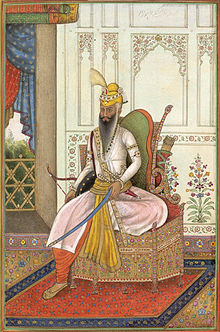
Maharaja Ranjit Singh
This Sikh Empire (co-joining 12 Misls), then fought numerous battles- the Battle of Amritsar, Battle of Guler, Battle of Anandpur, Afghan-Sikh Wars, Battle of Nadaun, Battle of Kartarpur, Battle of Lohgarh, Battle of Samana, Battle of Mukhtsar, Seige of Amritsar, Seige of Ram Rauni, Gurka- Sikh War, Battle of Ferozeshah, Sino-Sikh War to name a few.
One of the most prominent battles was the Afghan-Sikh Wars, which was in fact a series of battles. This battle was between Sikh Empire and Durrani Empire (in Afghanistan). The conflicts between these two empires were raised during the days of Dal Khalsa and continued even after the fall of the Durrani Empire. The first phase comprised of Ahmad Shah Durrani invading and occupying Lahore and marching to the east to take up more territory.
Exactly at this time, he was defeated by the Mughals in alliance with Sikhs at the Battle of Manupur. Ala Singh, Jassa Singh Ahluwalia, and Charat Singh continued to harass Durrani forces during the first invasion of Ahmad Shah, which was a fail.
Sikhs commended the guerilla war with the Afghans to kick them out of Punjab and even defeated their huge number of Army in the Battle of Gohalwar, Amritsar. Sikhs also put the Afghan prisoners to clean scared tanks in Amritsar that they previously disrespected.
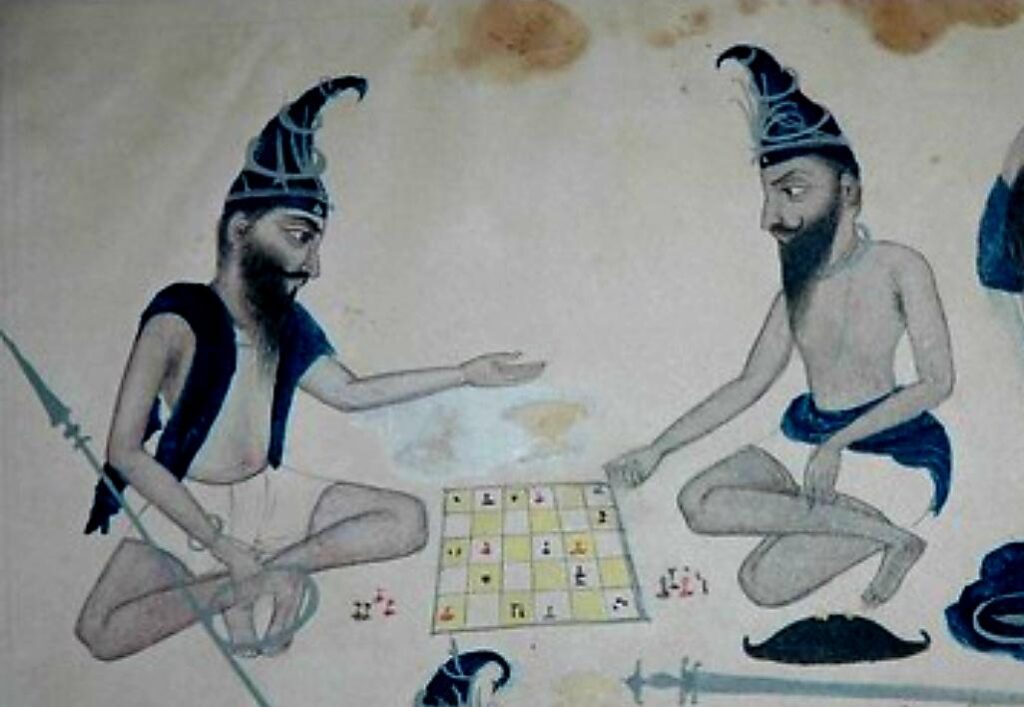
1820s – Nihang singhs playing chess …sikh empire
After Ahmad Shah Durrani died, the Durrani Empire was weak, but Timur Shah decided to attack when they find the opportunity against Sikhs. He sent an ambassador to the Sikhs attempting to please them with kind words to make peace.
However, Sikhs knew his intentions and showed arrogance and also quoted- “His highness Timur Shah is trying to scare us, but the fact of the matter is that he is afraid of us”. Next was the phase with Zaman Shah, who lead various campaigns of Punjab against Sikhs and captured Lahore.
In response to this, the Sikhs remain in peace to protect the holy city Amritsar. But, later when he progressed towards Amritsar, he was defeated 10 km far from the city and Zaman Shah was forced to leave his Punjab campaigns. After that, he even tried to resume his campaign but wasn’t successful.
Just like this, there was a fourth and fifth phase that included the Battle of Attock and Battle of Peshawar.
Lesson by Sikh Empire Battles
With bravery and an attitude of never backing down from any challenge, one can overcome every obstacle that comes in their life.
With a clear vision in mind and determination, one can win every battle.
With the ability to adapt, one can achieve admirable success toward achieving goals.
With the intention of respecting everyone, regardless of caste and creed, one can earn trust from people.
By applying the above-mentioned qualities, one can inspire others and make a positive impact.
Also Read: Everything You Need to Know About Diwali
Sikh Faith & Principles
Sikhs show their faith via five visual signs known as Five Kakars. One is the Sikh undergarment, which signifies health and modesty, the second is the steel wristlet also called Kara, which is a sign of faith, the third is a wooden comb to keep hair clean and untangled, the fourth is to keep hair uncut for the creator’s honor, and the fifth is a small sword that defends the religious rights.





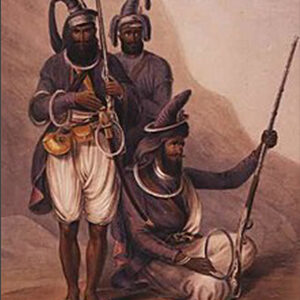
The main principles of Sikhism are- honest labor (Kirt Karna), sharing the earnings (Wand Chhakna), and meditating on Guru’s (God) name (Nam Japna). Sikhism stands for selfless service to the human race and the welfare of everyone. For this, it is acceptable to use the sword when you have used all the available resorts as per the preachings of Guru Gobind Singh Ji. Some widely accepted and applied concepts in Sikh Religion are- Bani and Bana (outer look and inner values), Concept of Amrit, Concept of creation theory, the concept of Degh Tegh, the concept of Miri, and Piri, the concept of democracy, liberty, and equality.
Summing Up this with principles and teachings of the Sikh faith
Founded by Guru Nanak, and its teachings are primarily recorded in the Guru Granth Sahib, the holy scripture of Sikhism. Here are some key principles and teachings of the Sikh faith:
Oneness of God: Sikhism emphasizes the belief in one, formless, and timeless God. The term “Ik Onkar” signifies the oneness of the divine.
Equality: Sikhs believe in the equality of all human beings, irrespective of caste, creed, gender, or nationality. Everyone is considered equal in the eyes of God.
Community Service: Service to humanity, known as “SEVA” in the Gurmukhi language is a major part of Sikhism. Sikhs are encouraged to engage in selfless service, helping those in need without any expectation of return.
Honest Living: Sikhs are encouraged to earn an honest living through hard work and integrity. They should avoid dishonest means of earning wealth by any means.
Remembering God Everytime: Sikhs are encouraged to remember and meditate on the divine name as it’s essential to deeply connect with god.
Sharing: Sikhs believe in sharing with others, particularly with those less fortunate. This principle encourages generosity and the spirit of giving. In Gurmukhi language it is popularly known as ‘Vand Chhako‘.
Equality of Women: Sikhism promotes the equality of women and men. The first Guru, Shri Guru Nanak Dev Ji, emphasized the respect for women through his words, ‘So Kyu Manda Aakhiye Jit Jamme Rajan,’ which translates to ‘Why call her inferior, from her, kings are born.’ Women in Sikhism have the same spiritual rights and responsibilities as men, and they can actively participate in all religious, social, and political activities.
Rejecting Rituals and Superstitions: Sikhism rejects rituals, superstitions, and idol worship. The focus is on a direct connection with the divine through prayer.
Community Worship: Sikhs gather in congregations for collective worship, singing hymns, and listening to the teachings of the Shri Guru Granth Sahib. This worship is known as “SATSANG” in sikhism.
Defending Justice: Sikhs are encouraged to stand up for justice and righteousness.
The ultimate goal is to lead a life of righteousness, devotion, and service to humanity while remembering and meditating on the divine.
Chessbazaar’s Sikh Empire Series:
Inspired by the Sikh Empire, we have introduce a dedicated product that reflects the cultural significance of the Sikh Empire from every perspective. In December 2022, we unveiled the Sikh Empire Series. Every member of the chessbazaar team, from artisans to other team members, put forth their honest and dedicated effort to launch the Sikh Empire series, just as we have done with every product provided to chess enthusiasts(know more from our satisfied customers) across the globe so far.
Now take a close at Chessbazaar’s Sikh Empire Series:
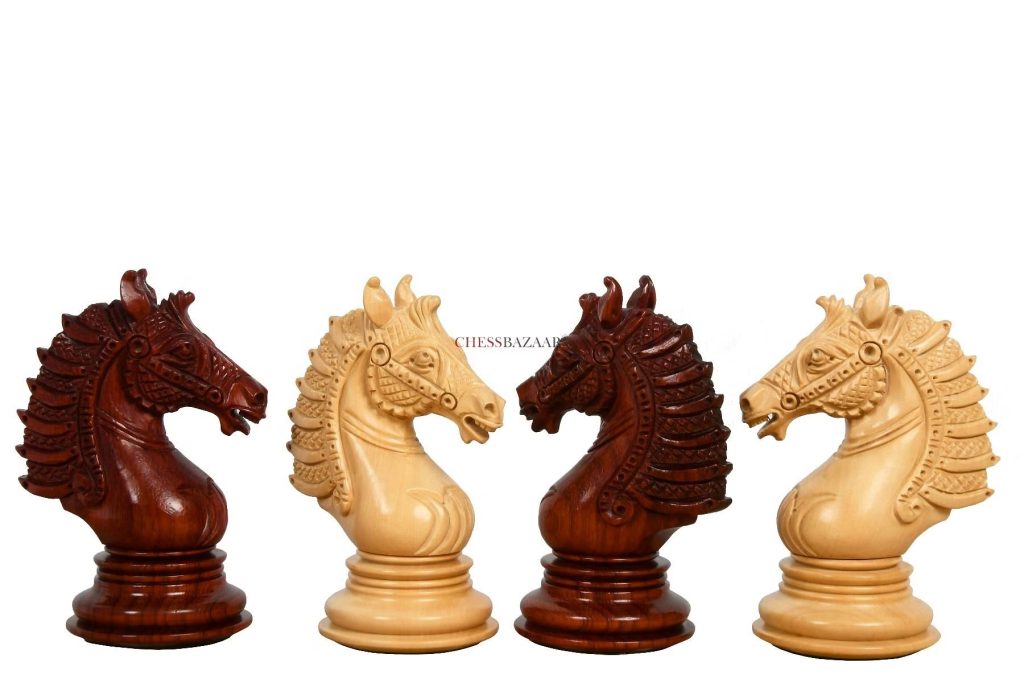
We are delighted to launch this in the vibrant combination of wood, i.e., Bud Rosewood (Padauk) and Indian Boxwood. The added weight makes these pieces truly fantastic and perfect for those seeking a well-balanced piece with the right weight. We have also included a matching chess board: Red Ash Burl Maple Hi Gloss Borderless 19″ – 60 mm, which is optional to purchase. If someone doesn’t have a chess board, they can buy the board by clicking here SKU-B1023 with the additional amount mentioned on our product page. Overall, at Chessbazaar, we would love to help people buy their dream chess set easily and comfortably.
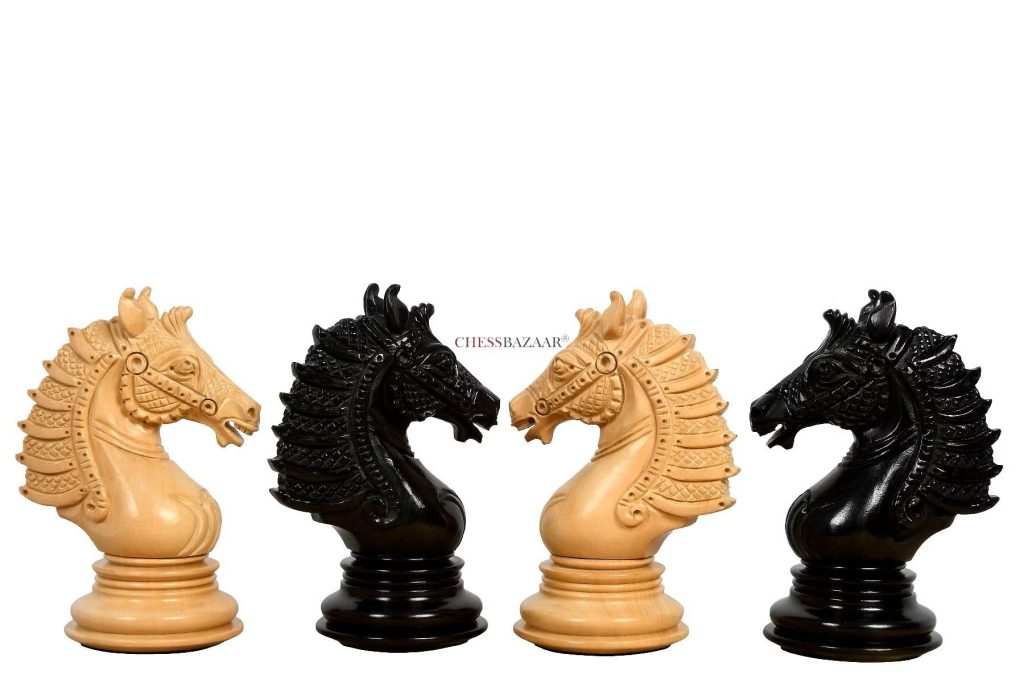
It is meant for those who have a fondness for Ebony wood, and due to this, we have dedicatedly launched this series in Ebony Wood and Indian Boxwood. Additionally, we have also included a matching boards i.e. B1007, D0141 with the Ebony and Indian Boxwood chess pieces. With attention to detail by our experienced artisans in the chess pieces, this series pleasantly surprised chess enthusiasts, collectors, and lovers globally.
